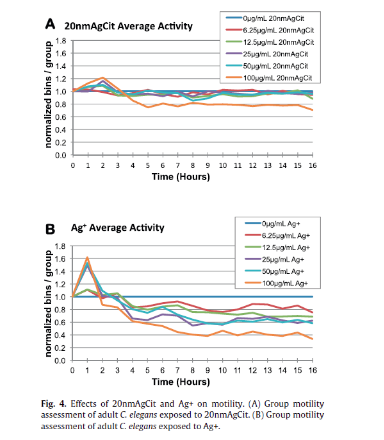
A small whole animal model such as the microscopic soil dwelling nematode Caenorhabditis elegans is likely to prove more predictive for oral toxicity. The trials performed with C. elegans can predict mammalian toxicity.
In this assay we evaluate the in vivo toxicity of silver nanospheres (AgNP) stabilized with a citrate coated (Agcit), versus ionic silver (Ag+)
- elegans motility assessment was done using wells of 12-well plates at 20 ◦C. Approximately 1000 freshly fed synchronized adult C. elegans in 900 L CeHM (Habitation Media ) were placed in wells and allowed to adapt to the well for 1 h, followed by a 60 min baseline motility assessment in the WMicrotracker One. 100 L of water or 10× dosing solution were then added to each well, and plates were returned to the WMicrotracker. Data was sampled in 60-min blocks, divided by the baseline reading, and then normalized to the water control. Each experiment was done in duplicate and repeated on three separate days.
The graph shows the effects of 20nmAgCit and Ag+ on nematode motility. (A) Group motility exposed to 20nmAgCit. (B) Group motility exposed to different concentrations of Ag+.

We found a slight initial peak of activity at 2 h of exposure to 20nm AgCit at the 100 g/mL dose, followed by a slight dip in motility of just 5 h. In contrast, exposure to 25, 50, or 100 g/mL Ag+ was associated with a 50–60% jump in activity at 1 h of exposure followed by a drop. Besides, it can be observed how an ion concentration 12.5 g/mL Ag+ produced the most similar motility pattern to that of 100 g/mL 20nmAgCit.
Toxicology Reports. Volume 1, 2014, Pages 923-944.
